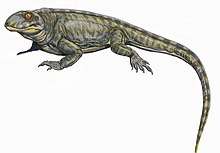Sphenacodontoidea
Sphenacodontoidea is a node-based clade that is defined to include the most recent common ancestor of the Sphenacodontidae and the Therapsida and their descendants (including mammals). They are defined according to a number of specialised characteristics concerning proportions of the bones of the skull and the teeth.
| Sphenacodontoids | |
|---|---|
 | |
| Examples of Sphenacodontoidea: Inostrancevia, Dimetrodon and Adelobasileus. | |
| Scientific classification | |
| Kingdom: | Animalia |
| Phylum: | Chordata |
| Clade: | Eupelycosauria |
| Clade: | Haptodontiformes |
| Clade: | Sphenacomorpha |
| Clade: | Sphenacodontia |
| Clade: | Sphenacodontoidea |
| Clades | |
The Sphenacodontoidea evolved from earlier Sphenacodontia such as Haptodus via a number of transitional stages of small, unspecialised pelycosaurs.
Classification
The following taxonomy follows Fröbisch et al. (2011) and Benson (2012) unless otherwise noted.[1][2]
Class Synapsida
- Sphenacodontoidea
- Family †Sphenacodontidae
- Therapsida
gollark: LYRICLY PLAY INFIPAGE
gollark: I spend my time oscillating around neutral.
gollark: The best date system.
gollark: The Fractal China nation.
gollark: This is recursive england by the way.
See also
References
- Jörg Fröbisch, Rainer R. Schoch, Johannes Müller, Thomas Schindler and Dieter Schweiss (2011). "A new basal sphenacodontid synapsid from the Late Carboniferous of the Saar-Nahe Basin, Germany" (PDF). Acta Palaeontologica Polonica. 56 (1): 113–120. doi:10.4202/app.2010.0039.CS1 maint: uses authors parameter (link)
- Benson, R.J. (2012). "Interrelationships of basal synapsids: cranial and postcranial morphological partitions suggest different topologies". Journal of Systematic Palaeontology. in press (4): 601–624. doi:10.1080/14772019.2011.631042.
- Laurin, M. and Reisz, R. R., 1997, Autapomorphies of the main clades of synapsids - Tree of Life Web Project
This article is issued from Wikipedia. The text is licensed under Creative Commons - Attribution - Sharealike. Additional terms may apply for the media files.
